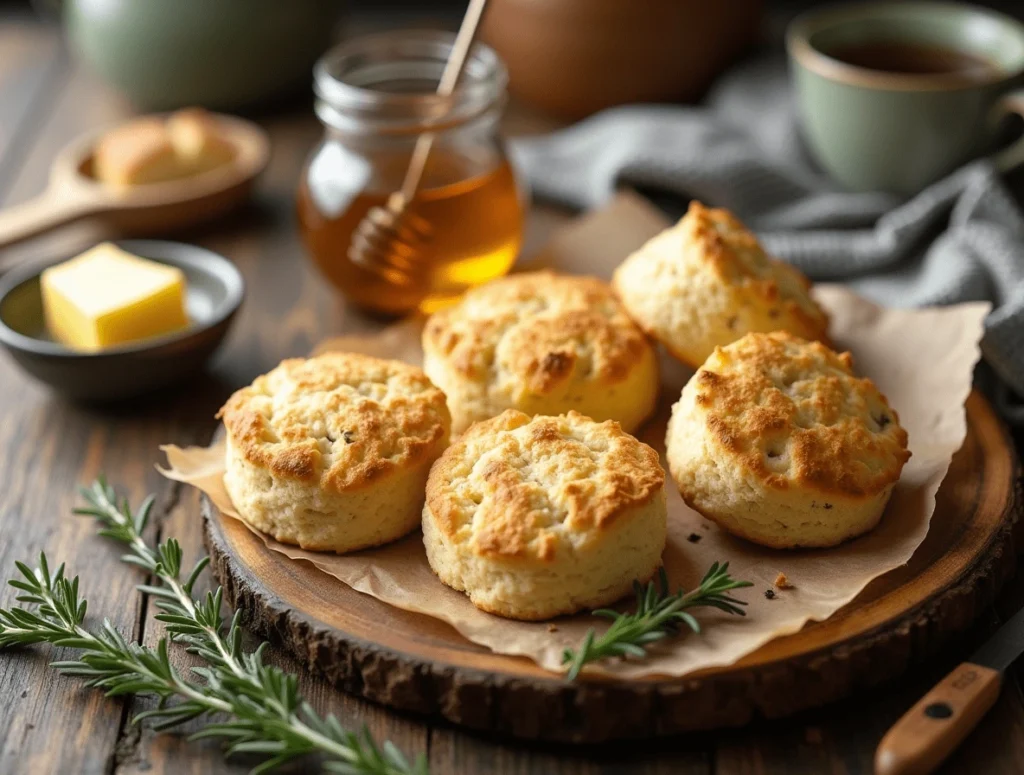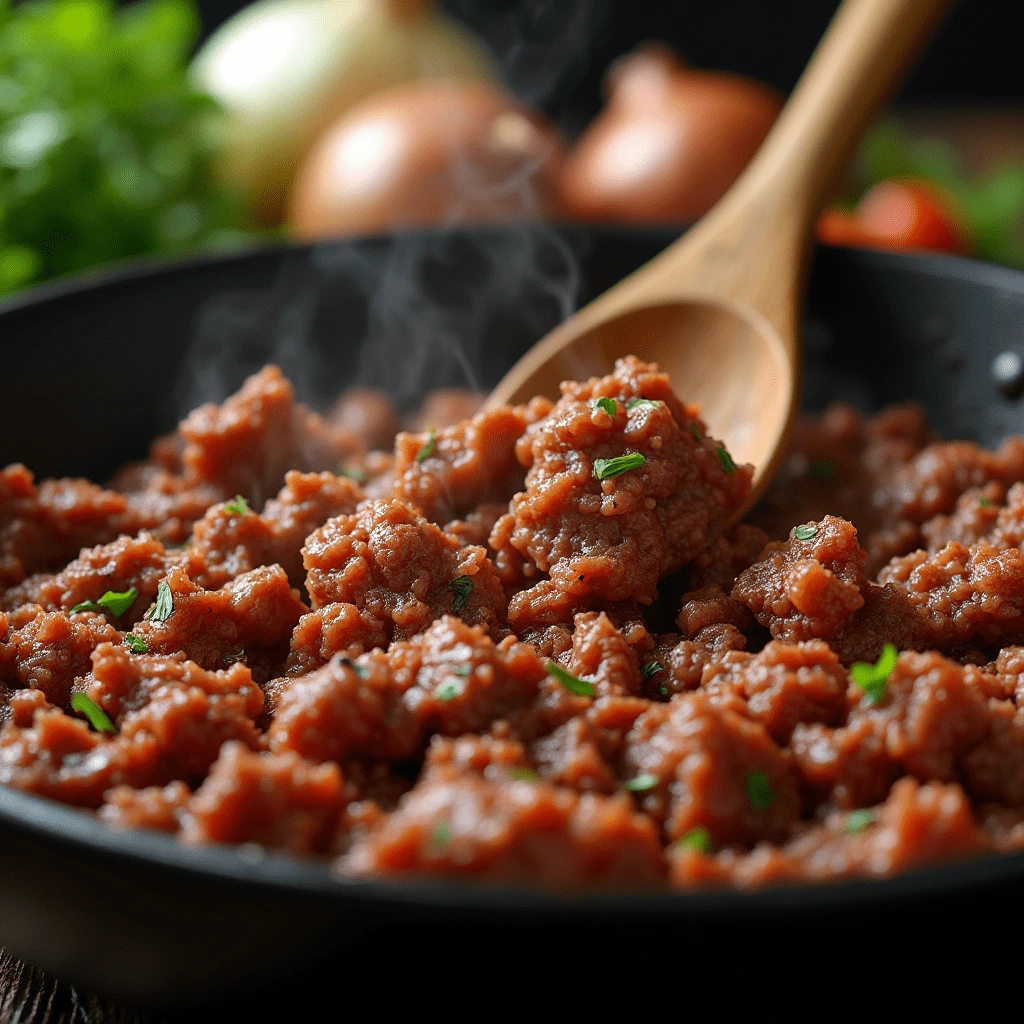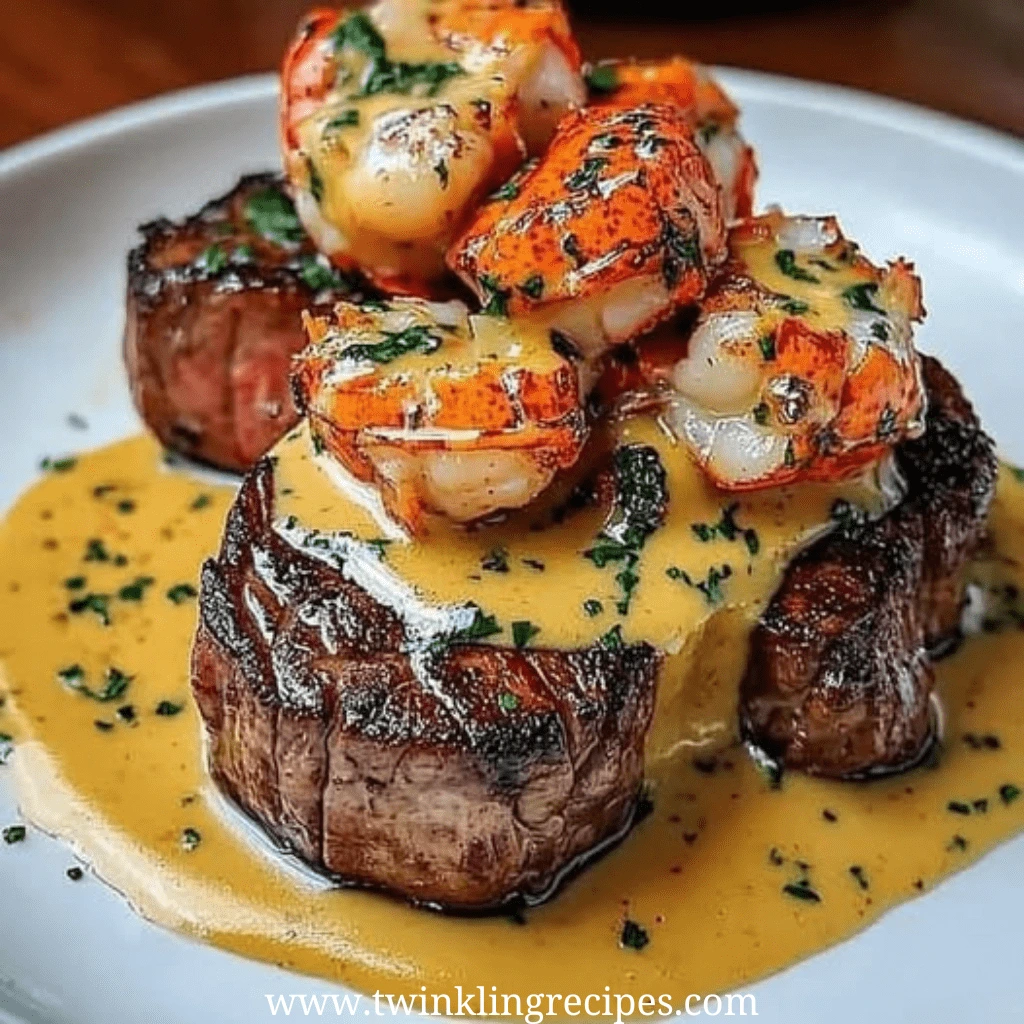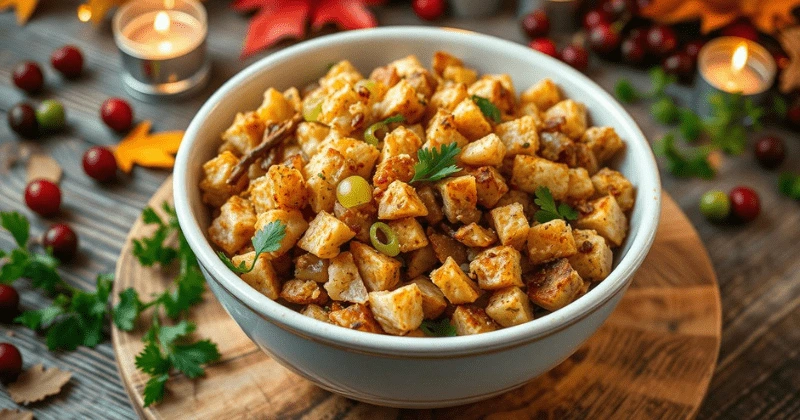Introduction:
Have you been searching for the perfect gluten-free biscuit that doesn’t sacrifice flavor or texture? You’re in the right place! Making fluffy, delicious gluten-free biscuits at home is easier than you might think. As someone who loves bringing comfort food to the table, I can’t wait to share this recipe with you.
These biscuits are not just a substitute:they’re a delight in their own right. Using simple ingredients and straightforward techniques, you’ll create biscuits that are golden on the outside and tender on the inside. Whether you’re pairing them with jam for breakfast or serving them alongside your favorite soup, they’re incredibly versatile and sure to impress.
Let’s dive into the world of gluten-free baking together. With this recipe, you’ll see that delicious, homemade biscuits are just a few steps away!
Table of Contents
Key Benefits of Gluten-Free Biscuits
Making gluten-free biscuits at home isn’t just about meeting dietary needs—it’s about creating something everyone at the table will enjoy. Here’s why this recipe is worth adding to your collection:
- Easy to Make: With simple ingredients and straightforward steps, this recipe is beginner-friendly, even if you’re new to gluten-free baking.
- Delicious and Versatile: These biscuits have a soft, fluffy texture with a golden crust, perfect for pairing with sweet jams, savory gravies, or even a drizzle of honey.
- Healthier Alternative: Using gluten-free flour allows those with gluten sensitivities or celiac disease to enjoy classic comfort food without worry.
- Customizable: This recipe is a blank canvas! You can add cheese, herbs, or spices to suit your meal or mood.
- Freshly Baked Goodness: Store-bought gluten-free biscuits often lack texture and flavor. Homemade biscuits bring freshness and quality that you can taste.
Whether you’re hosting a dinner, whipping up a family breakfast, or looking for a quick side dish, these biscuits are a versatile, crowd-pleasing choice. Let’s get baking!
Ingredients for Gluten-Free Biscuits
To create the perfect gluten-free biscuits, you’ll need a handful of simple ingredients that come together beautifully for a soft, fluffy texture and rich flavor. Here’s what you’ll need:

Dry Ingredients:
- Gluten-Free All-Purpose Flour (2 cups): Ensure it’s a blend with xanthan gum or guar gum for structure. If your mix doesn’t include this, you can add 1 teaspoon of xanthan gum separately.
- Baking Powder (1 tablespoon): Provides the lift needed for light, airy biscuits.
- Baking Soda (½ teaspoon): Enhances the fluffiness and balances the acidity.
- Salt (½ teaspoon): Brings out the flavors of all the ingredients.
Wet Ingredients:
- Cold Unsalted Butter (½ cup or 1 stick): The key to flaky layers! Cube the butter and keep it chilled until ready to use. For dairy-free options, substitute with cold coconut oil or vegan butter.
- Buttermilk (¾ cup): Adds a tangy richness and tender texture. You can make your own by mixing ¾ cup of milk with 1 tablespoon of lemon juice or vinegar.
- Honey or Sugar (1 tablespoon, optional): Adds a touch of sweetness, especially if serving with savory dishes.
Optional Add-Ins:
- Cheddar Cheese (½ cup): For savory biscuits, fold in shredded cheese.
- Fresh Herbs (2 tablespoons): Rosemary, thyme, or chives are great options for added flavor.
- Garlic Powder (½ teaspoon): For a subtle garlic kick.
Tips for Ingredient Success:
- Keep It Cold: Ensure your butter and buttermilk stay as cold as possible. This helps create those flaky layers you’ll love in a biscuit.
- Use a Quality Flour Blend: A good gluten-free flour mix is crucial. Look for one designed specifically for baking for the best results.
- Don’t Overwork the Dough: Mix just until combined to avoid dense biscuits. A little crumbly texture in the dough is perfectly fine!
With these ingredients prepped, you’re well on your way to baking golden, gluten-free perfection. Let’s move on to the step-by-step instructions!
How to Create Gluten-Free Biscuits: A Complete Guide
Picture sinking your teeth into a warm, buttery biscuit—soft, golden, and utterly scrumptious. Now imagine it’s gluten-free. Sounds unbelievable? Not at all! With these straightforward steps, you’ll soon quickly whip up these delightful goodies.
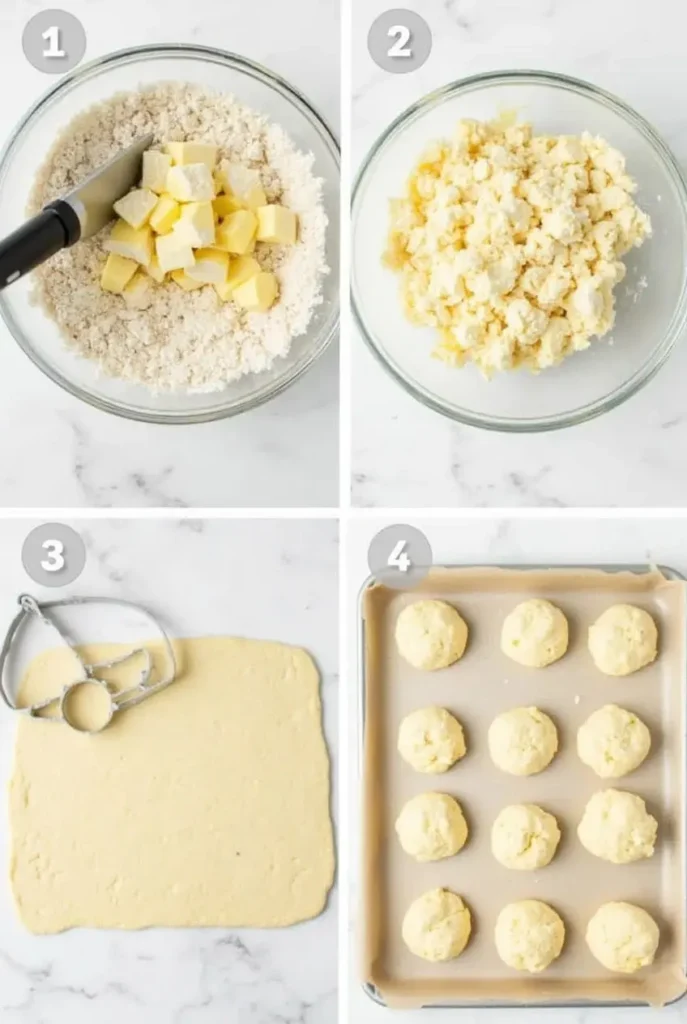
Prep the Essentials
Start by setting your oven to 425°F (220°C). Precision matters here—temperature can make or break the bake! Line a baking tray with parchment paper or a silicone sheet to ensure even cooking and prevent sticking disasters.
Gather your tools, such as a mixing bowl, whisk, pastry blender, and round cutter. Having everything within arm’s reach will make the process smooth and stress-free.
Combine the Dry Mix
In a large bowl, sift together the following ingredients:
- 2 cups gluten-free all-purpose blend
- 1 tablespoon leavening powder
- ½ teaspoon bicarbonate of soda
- ½ teaspoon seasoning salt
This step is more than combining—it’s about ensuring that each bite offers an even texture and balanced flavor.
Blend in the Butter
Cold butter is your best ally. Chop up ½ cup (1 stick) of unsalted butter into small chunks and toss them into your dry mixture. Use a pastry blender or your hands to crumble the butter into the flour until it looks like coarse sand. Pro tip: The colder the butter, the more delicate and flaky the biscuits.
Pour in the Buttermilk
Slowly drizzle in ¾ cups of buttermilk while stirring gently with a rubber spatula. The dough should come together with a slightly sticky but not overly wet consistency. Looking for a hint of sweetness? Stir in 1 tablespoon of honey or granulated sugar.
Shape the Dough with Care
Lightly dust your worktop with gluten-free flour. Turn out the dough and carefully press it into a rectangle about 1 inch thick. Fold the dough over itself once or twice—this layering technique creates those delectable flaky textures. Be cautious not to knead too much; the goal is a tender crumb.
Cut Out the Biscuits
If needed, take a biscuit cutter (or a glass) and press straight down into the dough. Avoid twisting, as it can disrupt the layers and affect the rise. Gather the leftover pieces, gently reshape the dough, and cut more rounds.
Bake to Perfection
Arrange the biscuits on your prepared tray. If you want soft sides, place them close together. If you prefer crispier edges, leave a bit of space between them. Slide them into the oven and bake for 12–15 minutes. Keep an eye on them—they should puff up and turn a beautiful golden hue.
Add the Finishing Touches
Once out of the oven, brush the tops with melted butter. This final step adds richness and elevates the flavor. Let them rest for a few minutes (if you can wait that long!) before serving warm.
Pro Tip for Biscuit Enthusiasts
For even taller biscuits, chill the dough for 10–15 minutes before baking. Cold dough keeps the butter solid, forming layers that bake up beautifully.
And there you have it—tender, airy, gluten-free biscuits sure to impress. Whether you slather them with butter, drizzle them with honey, or enjoy them plain, every bite will taste homemade perfection!
Pro Tips and Variations for Gluten-Free Biscuits
Making gluten-free biscuits can be even more enjoyable when you know a few insider tips and creative ways to customize them. Here’s how to perfect your biscuits and add your unique touch:
Pro Tips for Perfect Gluten-Free Biscuits
- Keep Ingredients Cold:
- Always use cold butter and buttermilk. The cold butter creates steam pockets during baking, resulting in flaky layers.
- For an extra chill, place your flour mixture in the freezer for a few minutes before cutting in the butter.
- Don’t Overwork the Dough:
- Mix the dough just until it comes together. Over-mixing can lead to dense, tough biscuits. A slightly sticky dough is ideal.
- Cut with Care:
- When using a biscuit cutter, press straight down without twisting. Twisting seals the edges and can prevent the biscuits from rising properly.
- Arrange Strategically:
- Place the biscuits close together on the baking sheet for softer biscuits. If you prefer crispier edges, space them slightly apart.
- Check for Doneness:
- Bake until the tops are golden brown and the biscuits feel firm. Overbaking can dry them out, so keep a close eye during the last few minutes.
Fun Variations to Try
- Cheesy Herb Biscuits:
- Mix in ½ cup of shredded cheddar cheese and two tablespoons of fresh herbs like chives, parsley, or thyme for a savory twist.
- Garlic Parmesan Biscuits:
- Add ½ teaspoon of garlic powder and ¼ cup of grated Parmesan to the dry ingredients for a bold, flavorful option.
- Sweet Biscuits:
- Stir two tablespoons of sugar and a teaspoon of vanilla extract to make lightly sweetened biscuits. These are perfect for pairing with fresh fruit or whipped cream!
- Spicy Kick Biscuits:
- Fold in a pinch of cayenne pepper and chopped jalapeños for biscuits with some heat. This recipe is excellent for serving with chili or stews.
- Vegan or Dairy-Free Biscuits:
- Substitute the butter with cold coconut oil or vegan butter, and use almond milk with a splash of lemon juice instead of buttermilk.
Actionable Tips for Success
- Use the Right Flour Blend: Not all gluten-free flour blends are equal. Look for one designed specifically for baking, including xanthan gum or guar gum for structure.
- Experiment with add-ons: Don’t hesitate to mix in your favorite flavors. From crumbled bacon to dried cranberries, the possibilities are endless!
- Store Leftovers Properly: Wrap biscuits in foil or store them in an airtight container at room temperature for up to 2 days. Reheat in the oven for a fresh-from-the-oven feel.
These tips and variations allow you to customize your gluten-free biscuits to suit any meal or occasion. Whether you keep them classic or try a creative twist, these biscuits will impress!
Variations and Flavor Additions for Gluten-Free Biscuits
The beauty of gluten-free biscuits lies in their versatility. With a few tweaks and added ingredients, you can create biscuits that suit any flavor profile or occasion. Here are some delicious variations and creative ways to elevate your biscuits.
Savory Variations
- Cheddar and Chive Biscuits:
- Add ½ cup shredded cheddar cheese and 2 tablespoons chopped fresh chives to the dough for a flavorful, savory biscuit. Perfect for pairing with soups or chili.
- Herb-Infused Biscuits:
- Stir in 2 tablespoons of fresh rosemary, thyme, or parsley for an aromatic twist. These biscuits are great as a side for roasted meats or stews.
- Garlic Parmesan Biscuits:
- Mix in ½ teaspoon garlic powder and ¼ cup grated Parmesan cheese to the dry ingredients. Brush the tops with garlic butter for extra flavor.
- Spicy Jalapeño Biscuits:
- Add 1 small, finely diced jalapeño and a pinch of cayenne pepper to give your biscuits a spicy kick. These are excellent for serving with barbecue or scrambled eggs.
Sweet Variations
- Cinnamon Sugar Biscuits:
- Sprinkle the dough with a mixture of 2 tablespoons sugar and 1 teaspoon cinnamon before baking. A drizzle of glaze on top transforms them into a delightful dessert.
- Lemon Blueberry Biscuits:
- Fold in ½ cup fresh or frozen blueberries and 1 teaspoon lemon zest for a refreshing, fruity biscuit. Serve them warm with a dollop of whipped cream.
- Maple Pecan Biscuits:
- Stir in ¼ cup chopped pecans and a splash of maple syrup for a nutty, sweet flavor. These biscuits are perfect for brunch spreads.
- Chocolate Chip Biscuits:
- Add ¼ cup mini chocolate chips to the dough for a treat that’s perfect for kids or as a quick dessert.
Dairy-Free and Vegan Options
- Coconut Milk Biscuits:
- Replace the buttermilk with canned coconut milk for a subtle tropical flavor. Pair these with sweet or savory dishes.
- Vegan Butter Substitutions:
- Swap the butter with cold vegan butter or solid coconut oil. Use a plant-based milk with a splash of vinegar to mimic buttermilk.
Tips for Customizing Your Biscuits
- Balance Flavors: When adding sweet or savory ingredients, adjust the salt and sugar in the base recipe to enhance the overall flavor.
- Don’t Overload the Dough: Be mindful not to add too many mix-ins, as this can affect the texture and baking consistency.
- Experiment with Spices: From cinnamon to smoked paprika, adding spices can transform your biscuits into something unique.
With these variations and flavor additions, you can tailor your gluten-free biscuits to suit any meal, season, or craving. Whether you prefer sweet, savory, or a mix of both, there’s a version here that’s perfect for you!
Serving Suggestions for Gluten-Free Biscuits
Gluten-free biscuits are more than just a side dish—they’re the perfect accompaniment to elevate any meal. Here are some serving ideas that blend practicality with creativity, ensuring every bite is as enjoyable as the last.

Breakfast Ideas
- Classic Morning Spread:
- Enjoy your biscuits warm with a pat of butter and a drizzle of honey or a spoonful of fruit preserves for a comforting start to the day.
- Breakfast Sandwich Delight:
- Split your biscuits and fill them with scrambled eggs, crispy bacon, and cheese for a hearty, grab-and-go breakfast.
- Sweet Morning Treat:
- Top your biscuits with a dollop of Greek yogurt, fresh berries, and a sprinkle of granola for a wholesome twist.
Lunchtime Favorites
- Pair with Soups or Salads:
- Serve your biscuits alongside a bowl of hearty soup or a fresh garden salad for a balanced and satisfying lunch.
- Mini Biscuit Sliders:
- Use biscuits as a base for sliders, layering in pulled pork, roasted vegetables, or chicken salad for a versatile and flavorful option.
- Savory Spread Snack:
- Smear your biscuits with avocado or a creamy hummus spread for a quick, savory snack.
Dinner Pairings
- Classic Comfort Food:
- Pair your biscuits with roasted chicken, turkey, or a rich beef stew for a timeless comfort meal.
- Southern-Style Biscuits and Gravy:
- Top your biscuits with homemade sausage gravy for a classic Southern-inspired dinner.
- Casserole Companion:
- Serve biscuits with casseroles like pot pie or baked pasta for a hearty and indulgent meal.
Dessert Ideas
- Strawberry Shortcakes:
- Transform your biscuits into desserts by layering them with whipped cream, macerated strawberries, and a touch of powdered sugar.
- Cinnamon Sugar Delight:
- Brush biscuits with melted butter, then sprinkle with cinnamon sugar for a simple and delicious dessert.
- Chocolate Biscuit Treat:
- Drizzle warm biscuits with melted chocolate or serve them with a scoop of ice cream for a decadent finale to your meal.
Pro Tips for Serving Biscuits
- Serve Warm for Maximum Flavor: Reheat biscuits in a low oven (at 350°F for a few minutes) to restore their warmth and softness.
- Create a Biscuit Bar: Offer a selection of sweet and savory toppings like honey, jams, cheeses, and gravy, letting everyone customize their own biscuit experience.
- Pair Thoughtfully: Match the flavor of your biscuits to the main course—savory biscuits complement soups and stews, while sweetened biscuits shine with fruit and desserts.
Storing and Reheating Gluten-Free Biscuits
Keeping gluten-free biscuits flavorful and fresh is simple when you follow the right steps! Here’s how to maintain their quality and reheat them effectively:
How to Store Gluten-Free Biscuits
- At Room Temperature (Short-Term):
- Ensure the biscuits are completely cooled before placing them in storage.
- Use a tightly sealed container, layering parchment or wax sheets between the pieces to prevent sticking.
- Store at room temperature for a maximum of two days.
- Chilling (Medium-Term):
- Pack the biscuits in a resealable plastic bag or airtight storage box, then refrigerate for up to five days.
- Refrigeration can cause slight drying, so reheating is recommended to restore their texture and moisture.
- Freezing (Long-Term):
- Spread the biscuits on a tray in a single layer and freeze until they’re solid.
- Once frozen, transfer them to a freezer-friendly bag or container to save space.
- Write the freezing date on the packaging and store it for up to three months.
How to Reheat Gluten-Free Biscuits
Warming biscuits properly ensures they regain their soft and delicious quality.
- Oven Method (Best Texture):
- Heat your oven to 350°F (175°C).
- Wrap the biscuits individually in aluminum foil to trap moisture.
- Warm for 10–12 minutes, or until heated all the way through.
- Microwave (Fastest Solution):
- Set a biscuit on a microwave-safe plate and cover it with a moist paper towel.
- Microwave on medium for 20–30 seconds, checking regularly to avoid overcooking.
- Toaster Oven (Crispy Option):
- Preheat the toaster oven to 325°F (160°C).
- Lay biscuits directly on the tray or rack and heat for 5–7 minutes for a lightly crispy exterior.
- Reheating from Frozen:
- Let frozen biscuits thaw at room temperature for about 30 minutes before reheating.
- Alternatively, reheat directly from the freezer by adding an extra 5 minutes to the oven or toaster oven method.
Pro Tips for Maintaining Freshness
- Add a thin layer of melted butter or drizzle a bit of honey on top before reheating to enhance moisture and flavor.
- Only heat as many biscuits as you need to enjoy immediately, leaving the remainder stored securely for future use.
By applying these tips, you’ll always have soft, flavorful gluten-free biscuits at your fingertips, ready to enjoy anytime, whether freshly baked or stored for later indulgence!
Common Mistakes to Avoid When Making Gluten-Free Biscuits
Even with the best intentions, a few missteps can turn your gluten-free biscuits from light and fluffy to dense and dry. By understanding these common errors, you can sidestep them and enjoy perfect results every time.
1. Using the Wrong Flour Blend
Gluten-free baking relies heavily on the right flour mix. Not all gluten-free flours are created equal, so it’s important to choose a gluten-free flour blend designed for baking. Avoid single-ingredient flours like almond or coconut flour unless the recipe explicitly calls for them, as they can drastically alter the texture.
2. Overmixing the Dough
One of the biggest culprits of dense biscuits is overworking the dough. Unlike traditional doughs, gluten-free mixtures don’t benefit from prolonged mixing. Instead:
- Combine ingredients until they’re just incorporated.
- Handle the dough gently to keep it tender and airy.
3. Skipping the Chilling Step
Cold butter or shortening is a must for achieving those desirable flaky layers. If your fat ingredients melt before baking:
- The biscuits will spread too much.
- You’ll lose that signature layered texture.
To avoid this, chill the dough for 15–20 minutes before shaping and baking.
4. Measuring Ingredients Incorrectly
Precise measurements are crucial for gluten-free recipes. Too much or too little flour can ruin the balance. Use the “spoon and level” method:
- Spoon flour into your measuring cup.
- Level off with a straight edge (don’t pack it down).
5. Ignoring Leavening Agents
Leavening agents like baking powder or baking soda give biscuits their lift. Skimping or mismeasuring can lead to flat, lifeless biscuits. Always double-check your amounts, and ensure they’re fresh for optimal rise.
6. Baking at the Wrong Temperature
Biscuits require a hot oven to rise quickly and set properly. A low temperature may cause them to spread or bake unevenly. Always preheat your oven to the specified temperature (usually around 375–400°F). Use an oven thermometer to ensure accuracy, as many ovens can run hotter or cooler than the dial indicates.
7. Not Adding Enough Moisture
Gluten-free doughs are often drier than their traditional counterparts, so it’s critical to include enough liquid. If your dough feels crumbly:
- Add a tablespoon of milk (or a non-dairy substitute) at a time until it holds together.
Pro Tip
Mistakes happen—even to seasoned bakers. If your biscuits don’t turn out as planned, take notes on what might have gone wrong and try again. Mastering gluten-free baking is a journey, and every attempt gets you closer to perfection!
By avoiding these common errors, you’ll be well on your way to creating soft, flaky, and irresistible gluten-free biscuits every time.

Gluten-Free Biscuits Recipe
Equipment
- Mixing Bowl For combining ingredients.
- Pastry Blender To cut cold butter into the flour.
- Whisk To blend dry ingredients evenly.
- Rubber Spatula For gently mixing the dough.
- Biscuit Cutter (or glass) To shape the biscuits.
- Baking Tray To bake the biscuits evenly.
- Parchment Paper or Silicone Baking Mat To prevent sticking.
- Brush (optional) For applying melted butter after baking.
Ingredients
Dry Ingredients:
- 2 cups Gluten-Free All-Purpose Flour with xanthan gum or add 1 tsp separately
- 1 tbsp Baking Powder
- ½ tsp Baking Soda
- ½ tsp Salt
Wet Ingredients:
- ½ cup 1 stick Cold Unsalted Butter (or substitute with vegan butter/coconut oil for dairy-free)
- ¾ cup Buttermilk or ¾ cup milk + 1 tbsp vinegar/lemon juice as a substitute
- 1 tbsp Honey or Sugar optional, for a touch of sweetness
Optional Add-Ins:
- ½ cup Shredded Cheddar Cheese for savory biscuits
- 2 tbsp Fresh Herbs like chives, rosemary, or thyme
- ½ tsp Garlic Powder for added flavor
Instructions
Preheat the Oven
- Preheat your oven to 425°F (220°C). Line a baking tray with parchment paper or a silicone baking mat.
Mix the Dry Ingredients
- In a large mixing bowl, whisk together the gluten-free flour, baking powder, baking soda, and salt.
Cut in the Butter
- Add the cold, cubed butter to the dry ingredients. Use a pastry blender or your fingers to mix until the butter forms coarse crumbs.
Add the Wet Ingredients
- Gradually pour in the buttermilk while stirring gently with a spatula. Add honey or sugar if using. Mix until just combined; the dough should be slightly sticky.
Shape the Dough
- Lightly flour a clean surface with gluten-free flour. Turn out the dough and press it into a rectangle about 1 inch thick. Fold the dough over itself 1–2 times to create flaky layers.
Cut the Biscuits
- Use a biscuit cutter or a glass to cut out rounds of dough. Avoid twisting the cutter to ensure proper rising. Gather scraps, reshape, and cut additional biscuits.
Arrange on the Tray
- Place the biscuits on the prepared baking tray. For softer sides, place them close together. For crispier edges, leave space between each biscuit.
Bake
- Bake in the preheated oven for 12–15 minutes, or until the biscuits are golden brown and puffed up.
Add the Finishing Touch
- Remove from the oven and brush the tops with melted butter for extra flavor. Let them cool slightly before serving.
Video
Notes
- Use a quality gluten-free flour blend with xanthan gum for structure.
- Keep butter and buttermilk cold for flaky biscuits.
- Avoid overmixing; handle dough gently for a tender texture.
- Fold dough for layers; don’t knead excessively.
- Bake until golden; adjust timing as ovens vary.
- Store airtight for 2 days or freeze unbaked biscuits for later.
- Customize with cheese, herbs, or spices to taste.
Conclusion: The Perfect Gluten-Free Biscuit Journey
Crafting gluten-free biscuits at home may seem like a challenge, but with the right techniques, it’s a truly rewarding experience. By following this recipe and its tips, you’re not just making biscuits; you’re creating moments of joy, comfort, and satisfaction.
Why This Recipe Works
- Adaptability: Whether you’re baking for yourself or loved ones, this recipe accommodates a variety of dietary needs and personal preferences.
- Flavors That Shine: Using quality ingredients ensures every bite is rich, buttery, and satisfying.
- Proven Techniques: From chilling the dough to selecting the best gluten-free flour blend, these steps guarantee success.
Celebrate Your Baking Success
Picture this: golden-brown biscuits, flaky on the outside and tender within, served warm with a pat of butter or drizzle of honey. Whether paired with hearty soups, enjoyed at breakfast, or served alongside a savory dinner, these biscuits elevate every meal.
A Final Encouragement
Don’t be afraid to experiment! Each attempt builds your skills and brings you closer to your ideal biscuit. Adjust flavors, try new add-ins, and find the combination that makes your taste buds dance.
Remember, even the best bakers started with small steps. With patience and practice, you’ll soon master the art of gluten-free baking, creating biscuits that rival even the finest bakeries.
FAQs
Which biscuits are naturally gluten-free?
Biscuits made with almond flour, coconut flour, or oat flour (certified gluten-free) are naturally Gluten-Free Biscuits. Variants like macarons or shortbreads using non-gluten grains are also safe options for those avoiding gluten.
What does gluten-free flour do in biscuits?
Gluten-free flour provides structure to Gluten-Free Biscuits using starches or gums as binders. It helps create a tender crumb, though additional moisture may be needed to prevent dryness.
Why are gluten-free biscuits so dry?
Gluten-Free Biscuits often lack elasticity since gluten binds moisture. Replacing gluten with gums or adding hydrating ingredients like yogurt can counteract dryness.
Do gluten-free biscuits taste the same?
Gluten-Free Biscuits may taste slightly different due to the unique flavors of alternative flours, but with proper recipes, they can be equally delicious and satisfyingly crisp.
What flour is gluten-free?
Almond, rice, coconut, and certified oat flours are commonly used in Gluten-Free Biscuits. Blended gluten-free flours ensure better texture and taste in baked goods.
What are the ingredients in gluten-free digestives?
Gluten-Free Biscuits like digestives typically include gluten-free flours, butter, sugar, baking powder, and xanthan gum to mimic the traditional biscuit texture.
What is the trick to baking with gluten-free flour?
To perfect Gluten-Free Biscuits, use a mix of flours, include a binding agent like xanthan gum, and slightly underbake to maintain moisture.
Are potatoes gluten-free?
Yes, potatoes are naturally gluten-free and can complement recipes for Gluten-Free Biscuits as a starch substitute or as part of a flour blend.
Why did my gluten-free biscuits not rise?
Lack of xanthan gum or improper leavening can cause Gluten-Free Biscuits to stay flat. Ensure the dough has enough binding agents and leaveners like baking powder.

